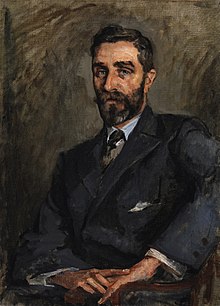
Back Roger Casement Afrikaans روجر كيسمنت Arabic روجير كاسيمينت ARZ Ruairí Mac Easmainn Breton Roger Casement Catalan Roger Casement Czech Roger Casement Welsh Roger David Casement Danish Roger Casement German Roger Casement Esperanto
Roger Casement | |
|---|---|
 Casement by Sarah Purser, 1914 | |
| Born | Roger David Casement 1 September 1864 Sandycove, County Dublin, Ireland |
| Died | 3 August 1916 (aged 51) Pentonville Prison, London, England |
| Cause of death | Execution by hanging |
| Monuments |
|
| Occupation(s) | Diplomat, poet, humanitarian activist |
| Organisation(s) | British Foreign Office, Irish Volunteers |
| Title | a knighthood for his efforts on behalf of the Amazonian Indians, having been appointed Companion of the Order of St Michael and St George (CMG) in 1905 for his Congo work. |
| Movement | |
| Parents |
|
Roger David Casement (Irish: Ruairí Dáithí Mac Easmainn;[1] 1 September 1864 – 3 August 1916), known as Sir Roger Casement, CMG, between 1911 and 1916, was a diplomat and Irish nationalist executed by the United Kingdom for treason during World War I. He worked for the British Foreign Office as a diplomat, becoming known as a humanitarian activist, and later as a poet and Easter Rising leader.[2] Described as the "father of twentieth-century human rights investigations",[3] he was honoured in 1905 for the Casement Report on the Congo and knighted in 1911 for his important investigations of human rights abuses in the rubber industry in Peru.[4]
In Africa as a young man, Casement first worked for commercial interests before joining the British Colonial Service. In 1891 he was appointed as a British consul, a profession he followed for more than 20 years. Influenced by the Boer War and his investigation into colonial atrocities against indigenous peoples, Casement grew to mistrust imperialism. After retiring from consular service in 1913, he became more involved with Irish republicanism and other separatist movements.
During World War I, he made efforts to gain German military aid for the 1916 Easter Rising that sought to gain Irish independence.[5] He was arrested, convicted and executed for high treason. He was stripped of his knighthood and other honours. Before the trial, the British government circulated excerpts said to be from his private journals, known as the Black Diaries, which detailed homosexual activities. Given prevailing views and existing laws on homosexuality, this material undermined support for clemency. Debates have continued about these diaries: a handwriting comparison study in 2002 concluded that Casement had written the diaries, but this was still contested by some.[6]
- ^ "Ruairí Mac Easmainn/Roger Casement: The Global Imperative". The University of Notre Dame & The University of Limerick. Retrieved 3 April 2022.
- ^ "Kerry marks first anniversary of Casement execution – Century Ireland". RTÉ.ie. Archived from the original on 19 January 2019. Retrieved 4 February 2019.
- ^ "Humanities InstituteRoger Casement: A Human Rights Celebration (1916–2016)". Dhi.ucdavis.edu. Archived from the original on 28 July 2019. Retrieved 4 February 2019.
- ^ "Roger Casement: Ten facts about the Irish patriot executed in 1916". The Irish Post. Archived from the original on 8 June 2020. Retrieved 8 June 2020.
- ^ Mitchell, Angus, ed. (2016). One Bold Deed of Open Treason: The Berlin Diary of Roger Casement 1914–1916. Merrion Press.
- ^ Mitchell, Angus (2012). "Phases of a Dishonourable Phantasy". Field Day Review. 8: 107 – via JSTOR.